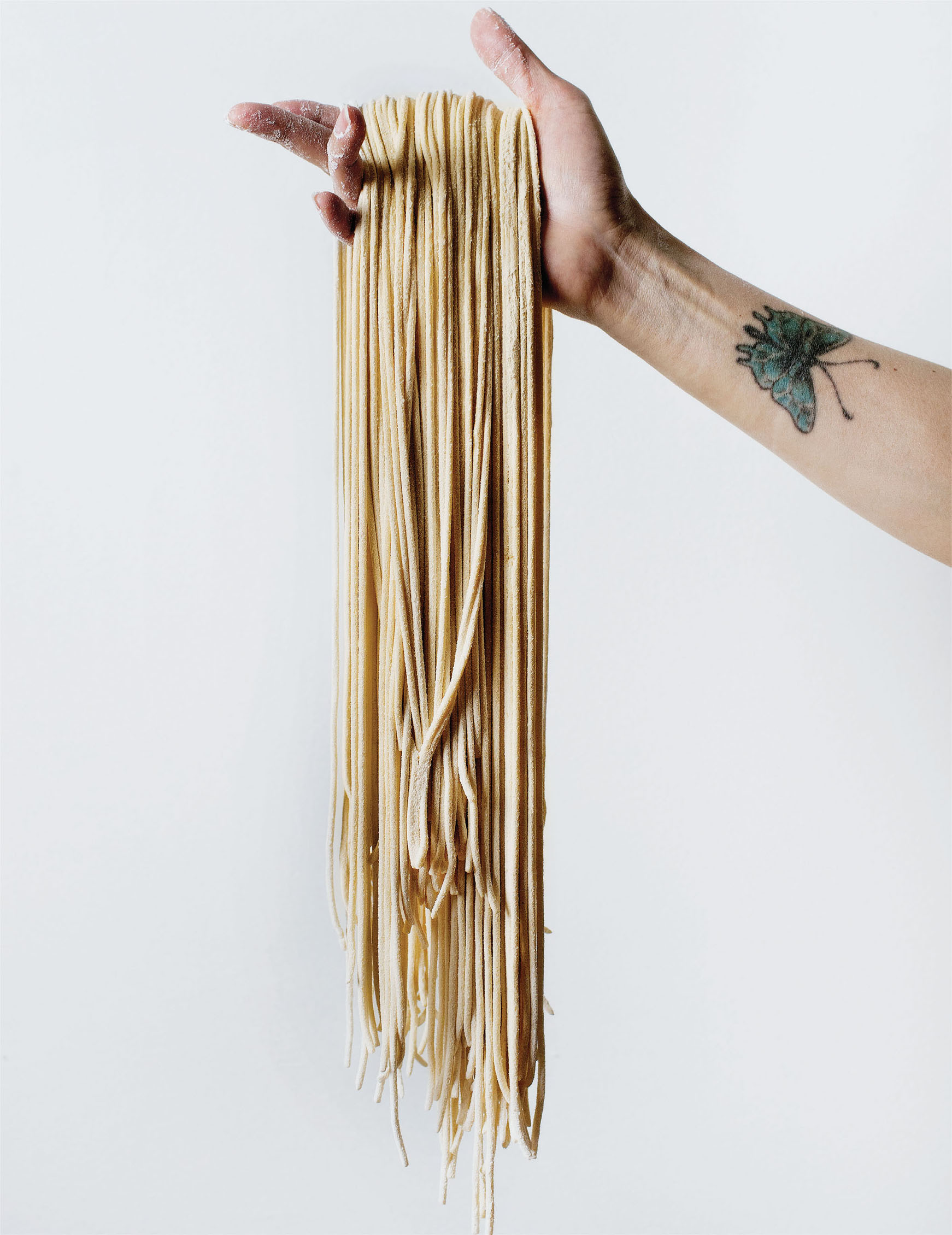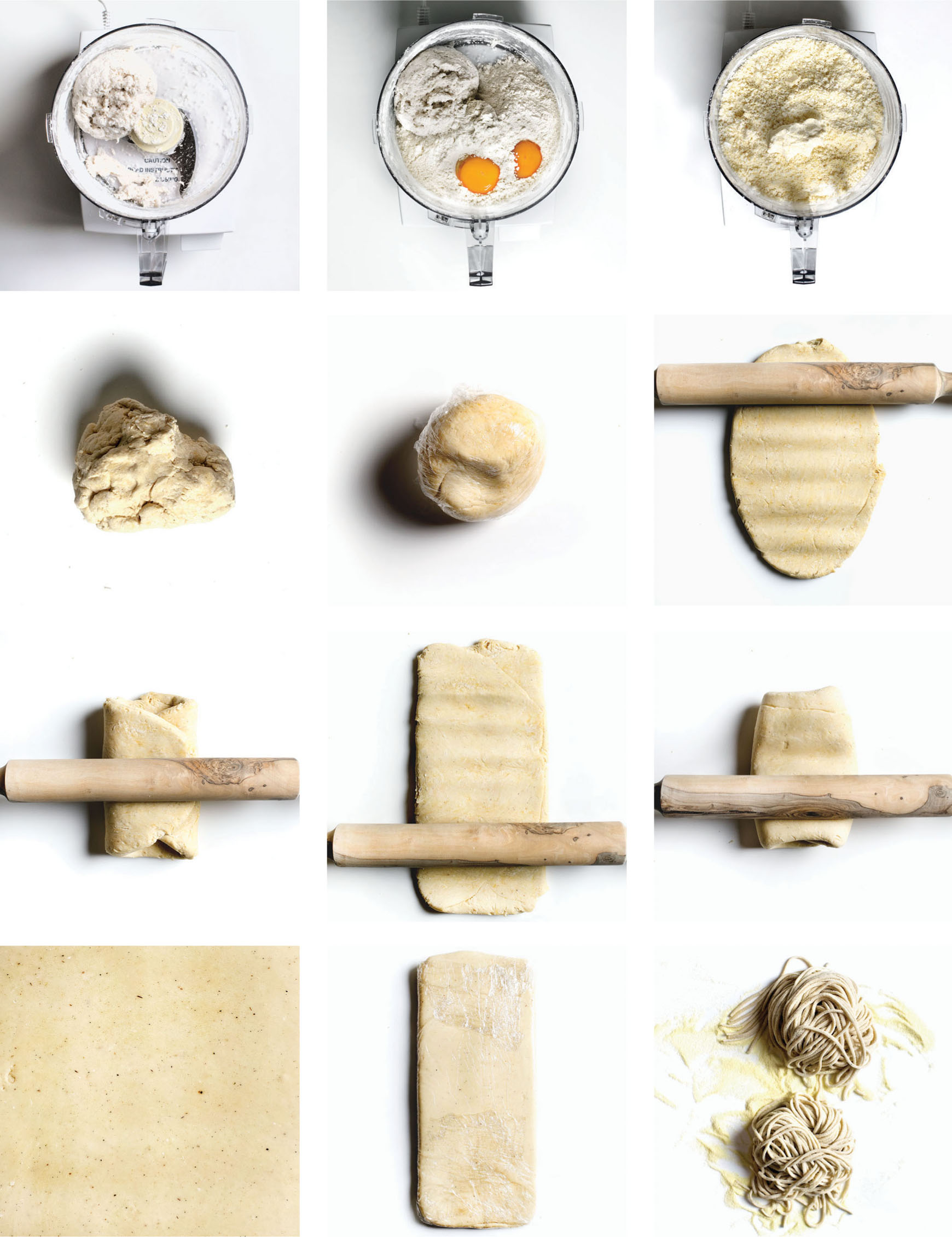
Forget it, there’s no point making ramen noodles at home. And by that, I’m talking about the traditional ramen noodles, which involve a combination of potassium carbonate and sodium carbonate called kansui that changes the pH level of the dough, giving the noodle a snappy and bouncy texture. Not only is kansui confusing to work with, but for me it leaves a bitter medicinal taste in the noodles that often seeps into the broth. And even if you think you enjoy that taste, know that professionally made ramen noodles are often aged for at least several days and up to weeks at precisely controlled temperature and humidity levels in order to reduce it. Most ramen noodle recipes don’t tell you that, and that’s why they taste like shit.
So what happens in an imperfect world in which both homemade and store-bought are no option? That’s where cheating comes in.
I don’t try to achieve that bouncy texture through kansui; I do it by using the underrated and dependable power of tapioca flour (aka tapioca starch). A wet tapioca flour dough cooks to a silky and chewy texture (think pão de queijo, the Brazilian cheese bread balls), but a dry tapioca flour dough gives a snappy and resistant bite. A dough made in between these two extremes, and in combination with wheat flour, finds the perfect sweet spot, for a homemade noodle that achieves a highly slurpable status without any unpleasant aftertaste. I also like to add a good amount of roasted barley tea powder for that beautiful freckled look and a whiff of extra flavor, but this recipe will work wonderfully well without it.
MAKES 4 SERVINGS
SPECIAL EQUIPMENT: electric pasta machine (not a hand-crank machine) or stand mixer with a pasta attachment (optional)
2 cups (224 g) tapioca flour
¾ teaspoon fine sea salt
¾ teaspoon roasted barley tea powder (optional)
2 cups (250 g) all-purpose flour, plus more for rolling the dough
3 large egg yolks
Semolina flour or all-purpose flour, for storing the noodles (optional)

MIX THE DOUGH
1. Bring a small saucepan of water to a simmer over medium heat.
2. Meanwhile, in a food processor, combine the tapioca flour, salt, and barley tea powder.
3. When the water reaches 210°F/100°C (boiling point), pour ¾ cup (180 mL) of the water evenly into the food processor. Pulse several times, until the mixture has clumped into a wet ball; then let cool for 5 minutes.
4. Add the all-purpose flour and egg yolks and pulse until the mixture resembles fine breadcrumbs, then scrape the sides of the bowl and continue to run for 1 full minute to blend thoroughly. The dough will look crumbly and dry, but you should be able to squeeze a large, damp lump together with your fingers. If the dough cannot come together like that, add 1 or 2 tablespoons more hot water and pulse to combine.
5. Piece two 20-inch- (50-cm-) long pieces of plastic wrap together along the long side to form an extra-large sheet. Squeeze the mixture into large lumps and transfer them onto the plastic wrap. Wrap the whole dough inside the plastic and knead it inside the wrap for 3 minutes. This is an extremely dry and hard dough, so put some muscle into it (the dough may still seem crumbly at first). Let the dough rest and hydrate in the wrap at room temperature for 30 minutes, then knead it again for another 3 minutes in the wrap. As time goes by, the dough will hydrate and become softer and easier to knead. At this stage, the dough will still look uneven, but it should not be overly crackling and dry to the touch. If it is, knead more water (a tablespoon or two; room temperature is fine) in until it isn’t. Let the dough rest for another 1 hour in the plastic wrap.
METHOD 1: ROLL AND CUT THE NOODLES WITH A PASTA MACHINE
1. This is my preferred method because it obviously saves a lot of labor. Unwrap the dough and roll it into a rectangle that’s just wide and thick enough to pass through the widest setting on your pasta machine or the pasta attachment on a stand mixer. Pass it through once, then fold the dough in thirds as if you’re folding a letter and pass it through the machine again. Repeat this process five to seven times, until the dough is very evenly colored, smooth, and silky. Pass the dough through the machine, narrowing the settings as you go, until it’s about ⅛ inch (3 mm) thick.
2. Switch the pasta machine to the spaghetti attachment. Feed the dough into the spaghetti attachment, lifting and moving the noodles away from the machine as it goes, so that they can stay straight and not get clumped up. Forget about any small, broken strands that fall underneath the pasta machine. I consider them collateral damage in the conflict between man and dough.
3. When the entire dough sheet has gone through, drench the noodles thoroughly with semolina or all-purpose flour. Cut the noodles in half lengthwise and divide them into 4 equal portions. Do not leave the noodles hanging at room temperature for more than 1 hour or they’ll stick together; if not using immediately, transfer them to a baking sheet and freeze until hard, then transfer to a zip-top bag and keep frozen until needed.
METHOD 2: ROLL AND CUT THE NOODLES BY HAND
1. Remove the plastic wrap and set the dough on the counter without flouring the counter (the dough won’t stick). Start flattening the dough out by pressing it with a large rolling pin (because it’s too tough to be rolled). I recommend doing this on a lower-height dining table rather than at a high kitchen counter, so that you can apply your body weight to the dough. Once flattened to about 10 × 6 inches (26 × 15 cm), fold the dough in three folds on the short side, as if you’re folding a letter, then press and flatten it again with the rolling pin. Repeat the folding and flattening as many times as you need to until the uneven dough has become even and smooth in texture and color (I’ve had to do it up to five times). Wrap the dough in plastic wrap and let it rest for 15 minutes.
2. Divide the dough in half. Roll one portion out into a large, thin rectangular sheet about 1/16 inch (2 mm) thick. Rub both sides evenly and generously with flour, then fold it over itself starting on the shorter end three or four times, so the width is shorter than the length of your knife. Cut the folded sheet crosswise into thin noodles about 1/16 inch (2 mm) wide (in other words, as wide as they are thick). Don’t rush it. Take your time. You want each noodle to be as even in size as possible.
3. Drench the noodles with semolina or all-purpose flour, fluff them to separate, and divide them into 2 equal portions. Do not leave the noodles at room temperature or they’ll stick together; transfer them to a baking sheet immediately and freeze until hard, then transfer to a zip-top bag and freeze until needed. Repeat to roll and cut noodles from the other half of the dough.